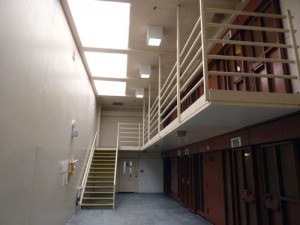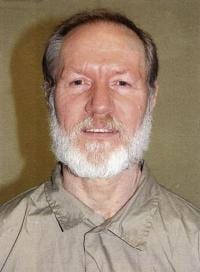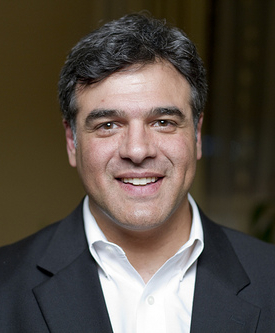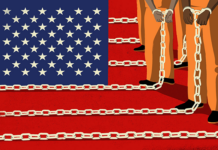
Anthony Gay is severely mentally ill. And like many Americans who suffer from severe mental illness and who commit a crime, he was placed in solitary confinement after his conviction, rather than in a mental hospital where he could have received treatment for his schizophrenia.
Isolated in a six-by-ten foot cell 24 hours a day, seven days a week, he spiraled into paranoia and began engaging in shocking self-mutilation. Gay stabbed himself in the eye with a razor blade. He cut off pieces of his own flesh and ate them. He cut out one of his own testicles and left it hanging on a cell door. He then stitched his scrotum closed with a zipper that he tore off his prison pants.
Instead of being transferred to a hospital, or even to the prison’s mental health unit, Gay had time added onto his sentence, all of it in solitary. His seven-year sentence eventually became 97 years. What was his crime? He was convicted in 1993 of stealing a $1 bill. Gay was scheduled for release in 2093 until a judge finally recognized that the system had failed him. He was eventually released from prison and sent to a hospital, but not until he had already spent 22 years in solitary.

Solitary confinement is the practice of isolating a prisoner from all human contact for an extended period of time. It is often used as a form of punishment or to control behavior, but it can have serious negative effects on mental health.
Most countries around the world limit the time that a prisoner can spend in solitary to 15 days. The United States doesn’t. There are scores of prisoners across the U.S. who have been in solitary for years and, in some cases, for decades. It should be clear to everybody—the courts, the states, and the federal Bureau of Prisons—that solitary only worsens already bad situations. It shouldn’t be in use.
We already knew that, of course. Solitary confinement as a punishment was invented in 1829 at Eastern State Penitentiary in Philadelphia, PA. The idea was to build an imposing, neo-Gothic, escape-proof maximum-security penitentiary where every prisoner was kept in solitary confinement. Each tiny cell had nothing but a bed, a chair, a small table, a chamber pot, and a bible. The idea was that if the prisoner had nothing to do with his time other than to read the bible, he would be a good, law-abiding Christian man by the time he was released. Instead, everybody went insane.

There is a growing body of research that shows that solitary confinement as it is used today can cause a variety of severe psychological problems, including anxiety, depression, paranoia, hallucinations, and suicidal thoughts. These problems can be so severe that they can lead to long-term disability or even death.
A true account of the number of mentally-ill prisoners held in solitary confinement in the United States could fill a library. But the stories are generally consistent. The longer a person is held in solitary, the worse his mental state becomes.
The younger a person is when he begins a sentence in solitary, the worse his mental state becomes. And the situation is usually hopeless when a person who is already mentally ill is placed in solitary, whatever his age. It’s no wonder that the United Nations has declared the U.S. practice of solitary confinement to be a form of torture:
- Cesar Villa, a prisoner in the solitary confinement unit at Pelican Bay State Prison in California wrote in his 12th year in solitary, “Nothing can really prepare you for entering the SHU (Segregated Housing Unit). It’s a world unto itself where cold, quiet and emptiness come together, seeping into your bones, then eventually the mind. The first week I told myself: It isn’t that bad, I could do this. The second week, I stood outside in my underwear shivering as I was pelted with hail and rain. By the third week, I found myself squatting in a corner of the yard, filing fingernails down over coarse concrete walls. My sense of human decency dissipated with each day. At the end of the first year, my feet and hands began to split open from the cold. I bled over my clothes, my food, between my sheets. Band-aids were not allowed, even confiscated when found. My sense of normalcy began to wane…Though I didn’t realize it at the time—looking back now—the unraveling must’ve begun then. My psyche had changed—I would never be the same.”


- Thomas Silverstein, who spent 28 years in solitary in the U.S. Penitentiary in Atlanta before dying there, wrote, “The cell was so small that I could stand in one place and touch both walls simultaneously. The ceiling was so low that I could reach up and touch the hot light fixture. My bed took up the length of the cell, and there was no other furniture at all…The walls were solid steel and painted all white…Shortly after I arrived, the prison staff began construction, adding more bars and other security measures to the cell while I was within it…It is hard to describe the horror I experienced during this construction process. As they built new walls around me it felt like I was being buried alive…Due to the unchanging bright artificial lights and not having a wristwatch or clock, I couldn’t tell if it was day or night. Frequently, I would fall asleep and when I woke up I would not know if I had slept for five minutes or five hours, and would have no idea of what day or time of day it was…I now know that I was housed there for about four years, but I would have believed it was a decade if that is what I was told. It seemed eternal and endless and immeasurable.”

- William Blake called his 25 years in solitary “a sentence worse than death,” and added, “I’ve experienced times so difficult and felt boredom and loneliness to such a degree that it seemed to be a physical thing inside—so thick it felt like it was choking me, trying to squeeze the sanity from my mind, the spirit from my soul, and the life from my body. I’ve seen and felt hope becoming like a foggy ephemeral thing, hard to get a hold of, even harder to keep a hold of as the years and then decades disappeared while I stayed trapped in the emptiness of the SHU world. I’ve seen minds slipping down the slope of sanity, descending into insanity, and I’ve been terrified that I would end up like the guys around me that have cracked and become nuts. It’s a sad thing to watch a human being go insane before your eyes because he can’t handle the pressure that the box exerts on the mind, but it is sadder still to see the spirit shaken from a soul. And it is more disastrous. Sometimes the prison guards find them hanging and blue; sometimes their necks get broken when they jump from their bed, the sheet tied around the neck that’s also wrapped around the grate covering the light in the ceiling snapping taut with a pop. I’ve seen the spirit leaving men in SHU and have witnessed the results.”

- In 2016, Kalief Browder killed himself after spending three years in solitary confinement at Rikers Island jail in New York City. Browder was 16 years old when he was arrested for allegedly stealing a backpack. He was never convicted of a crime, but he was held in solitary while he awaited trial. Browder’s family said that he suffered from severe psychological problems while in solitary confinement, including anxiety, depression, and paranoia.

- And although less common, women also are held in solitary. Sarah Jo Pender spent five years in the Indiana Women’s Prison solitary confinement unit after a nonviolent prison escape. She wrote, “Women who enter sane will become so depressed that they shut down or hurt themselves. I watched a woman claw chunks of flesh from her cheeks and nose and write on the window with her own blood. My neighbor bashed her head against the concrete until officers dragged her to a padded cell…Right across from my cell, a woman slit her own throat with a razor and was wheeled out on a gurney. Two others tried to asphyxiate themselves with bras and shoestrings. Now no one has shoestrings and we shuffle around in floppy tennis shoes with loose tongues…Another woman cut her wrists using the metal band around a pencil eraser. Now, all our pencils are stripped naked. It is always the poor prisoner porter who is forced to clean up the blood puddles and shit smears left behind when someone’s mind spirals down the rabbit hole.”
The research on the effects of solitary confinement on mental health is clear: Nothing good comes of solitary. It causes or exacerbates serious psychological problems and frequently leads to long-term disability or even death.
The United Nations condemns it and much of the rest of the world won’t practice it in their own prisons. It is a living example of the failure of the both the U.S. prison system and the U.S. mental healthcare system.
Repairing those will take a great deal of time, money, and effort. But the very first step must be to end solitary confinement.

CovertAction Magazine is made possible by subscriptions, orders and donations from readers like you.
Blow the Whistle on U.S. Imperialism
Click the whistle and donate
When you donate to CovertAction Magazine, you are supporting investigative journalism. Your contributions go directly to supporting the development, production, editing, and dissemination of the Magazine.
CovertAction Magazine does not receive corporate or government sponsorship. Yet, we hold a steadfast commitment to providing compensation for writers, editorial and technical support. Your support helps facilitate this compensation as well as increase the caliber of this work.
Please make a donation by clicking on the donate logo above and enter the amount and your credit or debit card information.
CovertAction Institute, Inc. (CAI) is a 501(c)(3) non-profit organization and your gift is tax-deductible for federal income purposes. CAI’s tax-exempt ID number is 87-2461683.
We sincerely thank you for your support.
Disclaimer: The contents of this article are the sole responsibility of the author(s). CovertAction Institute, Inc. (CAI), including its Board of Directors (BD), Editorial Board (EB), Advisory Board (AB), staff, volunteers and its projects (including CovertAction Magazine) are not responsible for any inaccurate or incorrect statement in this article. This article also does not necessarily represent the views the BD, the EB, the AB, staff, volunteers, or any members of its projects.
Differing viewpoints: CAM publishes articles with differing viewpoints in an effort to nurture vibrant debate and thoughtful critical analysis. Feel free to comment on the articles in the comment section and/or send your letters to the Editors, which we will publish in the Letters column.
Copyrighted Material: This web site may contain copyrighted material the use of which has not always been specifically authorized by the copyright owner. As a not-for-profit charitable organization incorporated in the State of New York, we are making such material available in an effort to advance the understanding of humanity’s problems and hopefully to help find solutions for those problems. We believe this constitutes a ‘fair use’ of any such copyrighted material as provided for in section 107 of the US Copyright Law. You can read more about ‘fair use’ and US Copyright Law at the Legal Information Institute of Cornell Law School.
Republishing: CovertAction Magazine (CAM) grants permission to cross-post CAM articles on not-for-profit community internet sites as long as the source is acknowledged together with a hyperlink to the original CovertAction Magazine article. Also, kindly let us know at info@CovertActionMagazine.com. For publication of CAM articles in print or other forms including commercial internet sites, contact: info@CovertActionMagazine.com.
By using this site, you agree to these terms above.
About the Author

John Kiriakou was a CIA analyst and case officer from 1990 to 2004.
In December 2007, John was the first U.S. government official to confirm that waterboarding was used to interrogate al-Qaeda prisoners, a practice he described as torture.
Kiriakou was a former senior investigator for the Senate Foreign Relations Committee and a former counter-terrorism consultant. While employed with the CIA, he was involved in critical counter-terrorism missions following the terrorist attacks of September 11, 2001, but refused to be trained in so-called “enhanced interrogation techniques,” nor did he ever authorize or engage in such crimes.
After leaving the CIA, Kiriakou appeared on ABC News in an interview with Brian Ross, during which he became the first former CIA officer to confirm the existence of the CIA’s torture program. Kiriakou’s interview revealed that this practice was not just the result of a few rogue agents, but was official U.S. policy approved at the highest levels of the government.
Kiriakou is the sole CIA agent to go to jail in connection with the U.S. torture program, despite the fact that he never tortured anyone. Rather, he blew the whistle on this horrific wrongdoing.
John can be reached at: jkiriakou@mac.com.










